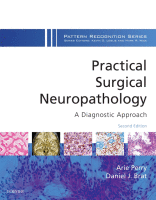Physical Address
304 North Cardinal St.
Dorchester Center, MA 02124

Definition and Synonyms Primary central nervous system lymphomas (PCNSLs) and histiocytic tumors are neoplasms that correspond histologically to their nodal or systemic counterparts, but lack an apparent systemic manifestation at the time of initial presentation. The most common types (hereafter…

Introduction Epithelial structures are scarce in the normal central nervous system (CNS). Only the choroid plexus ( Fig. 16.1A ) and the pituitary gland's anterior and intermediate lobes contain true epithelial cells. The latter are derived from Rathke pouch epithelium…

Introduction Peripheral nerves consist of nerve sheaths and their invested axons lying both within and outside the craniospinal dura. The axons arise from centrally or peripherally situated neurons ( Fig. 15.1 ). Of all nerve sheath cells, Schwann cells are…

Introduction Mesenchymal tumors are believed to originate from precursor mesodermal cells that develop into bone, cartilaginous or connective tissues such as blood vessels, adipocytes, smooth muscle cells, and fibroblasts. Thus, tumors considered in this category cover the entire spectrum of…

Introduction and Proposed Etiologies Meningiomas are among the most common of central nervous system (CNS) neoplasms and are by far the most common of the extra-axial tumors. Our understanding of meningioma classification, grading, and molecular genetics has evolved greatly over…

Definition and Synonyms Embryonal tumors of the central nervous system (CNS) manifest as highly cellular, poorly differentiated, and mitotically active neoplasms that are reminiscent of the developing embryonic nervous system. Such tumors constitute the most common group of malignant pediatric…

Introduction, Definitions, and Synonyms The pineal gland is a unique midline organ located posterior to the third ventricle in the quadrigeminal cistern. It is surrounded by the splenium of the corpus callosum above, the thalami laterally, and the quadrigeminal plate…

Brief Historical Overview The neuronal and mixed glioneuronal category of central nervous system (CNS) tumors has been expanding over the past 60 years. In the first edition of the Armed Forces Institute of Pathology (AFIP) fascicle (1952) and the first…

Introduction Not all brain tumors fit neatly into well-defined diagnostic categories within accepted classification systems. Such is the case with the three rare neoplasms discussed in this chapter: angiocentric glioma, astroblastoma, and chordoid glioma. Each of these has a unique…

Ependyma and choroid plexus play critical structural and biologic functions within the central nervous system (CNS); the neoplasms that recapitulate these cell types are the most common intraventricular and intramedullary spinal cord tumors. This chapter covers the various categories of…